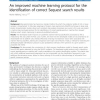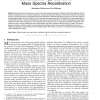BMCBI
2010
14 years 16 days ago
2010
Background: Mass spectrometry has become a standard method by which the proteomic profile of cell or tissue samples is characterized. To fully take advantage of tandem mass spectr...
BMCBI
2004
14 years 3 months ago
2004
Background: Recent technological advances in mass spectrometry pose challenges in computational mathematics and statistics to process the mass spectral data into predictive models...
BMCBI
2004
14 years 3 months ago
2004
Background: Recently, mass spectrometry data have been mined using a genetic algorithm to produce discriminatory models that distinguish healthy individuals from those with cancer...
BMCBI
2005
14 years 3 months ago
2005
Background: Protein-protein, protein-DNA and protein-RNA interactions are of central importance in biological systems. Quadrapole Time-of-flight (Q-TOF) mass spectrometry is a sen...
BMCBI
2005
14 years 3 months ago
2005
Background: Biological Mass Spectrometry is used to analyse peptides and proteins. A mass spectrum generates a list of measured mass to charge ratios and intensities of ionised pe...
TCBB
2008
14 years 3 months ago
2008
Mass spectrometry has become one of the most popular analysis techniques in Proteomics and Systems Biology. With the creation of larger data sets, the automated recalibration of ma...
BMCBI
2007
14 years 3 months ago
2007
Background: Structure elucidation of unknown small molecules by mass spectrometry is a challenge despite advances in instrumentation. The first crucial step is to obtain correct e...
BMCBI
2006
14 years 3 months ago
2006
Background: Statistical comparison of peptide profiles in biomarker discovery requires fast, userfriendly software for high throughput data analysis. Important features are flexib...
BMCBI
2006
14 years 3 months ago
2006
Background: Proteomic data obtained from mass spectrometry have attracted great interest for the detection of early-stage cancer. However, as mass spectrometry data are high-dimen...
BMCBI
2006
14 years 3 months ago
2006
Background: Nowadays, a variety of (bio-)polymers can be analyzed by mass spectrometry. The detailed interpretation of the spectra requires a huge number of "hypothesis cycle...




